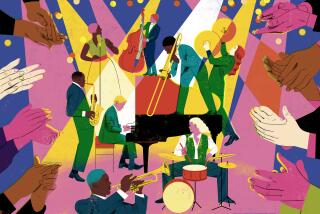JAZZ REVIEW : A Night of Unrestrained Sax With Gato Barbieri
SAN JUAN CAPISTRANO — A Gato Barbieri performance is not so much a jazz concert as it is a geothermal incident. The Argentine tenor saxophonist certainly has his jazz credentials, having worked with a range spanning Lalo Schifrin and avant garde trumpeter Don Cherry before taking off on his own in 1969. But the sound pouring from his instrument’s bell at the Coach House Friday evening was nothing short of a volcanic eruption.
The U.S. audience became aware of Barbieri largely through his soundtrack to Bernardo Bertolucci’s 1973 “Last Tango in Paris,” where the on-screen passions of Marlon Brando and Maria Schneider were buttered by Barbieri’s torrential sax.
His performance Friday drew chiefly from his ‘70s and ‘80s A&M; label albums. The segues between most numbers--which themselves were made up of several movements flowing into each other--made the 70-minute show a nearly nonstop gusher of the black-hatted saxman’s raw, sinewy R&B-grade; honks, densely clustered flurries of notes and unfettered upper-register shrieks.
Even in the performance’s relatively subtler passages on the sultry ballad “I Want You,” his soloing was never less than explosive, as if he were consistently trying to push more through his instrument than it would bear.
Heavily influenced by John Coltrane, Barbieri’s playing can be reminiscent of Pharaoh Sanders’ post-Trane work. But where Sanders’ music follows the spiritual, eternity-striving bent of Coltrane, Barbieri’s playing is far more worldly, rooted specifically in the blood and soil of South America.
Like much of Sanders’ work, Barbieri’s “Overture” and “She Is Michelle” opened on free-time plateaus of sound, where the rhythm was left floating as members of his quartet instead applied their energies to creating dense a-rhythmic, root-chord landscapes for the horn to blast over. But, where Sanders can be happy hovering in such places for half an hour, dissipating the tension, Barbieri would abruptly jut a finger in the air and send the band spiraling into tangled polyrhythmic forests.
Barbieri’s playing forged into progressively wilder jungles, his sax often seeming like dozens of animals forced to use a single throat. When notes alone wouldn’t suffice, phrases would be punctuated by reed-clamping shrieks of harmonics or by Barbieri leaning over to the microphone to let out an exultant cry.
When the music took up a decidedly more urban beat on the 1976 “Fiesta” it didn’t grow any tamer, instead seeming like the theme for a mardi gras held in the midst of a burning city.
The quartet of pianist Eddie Martinez, bassist Nillson Maha, drummer Robbie Gonzales and percussionist Germe Franco piled Latin rhythm on top of rhythm and was always wary of Barbieri’s upraised index finger signaling a new course. Barbieri’s outpouring left scant room for other solos, though Martinez did manage one playful mouse-on-the-keyboard interlude.
A scorching encore of “Viva Emiliano Zapata,” where Barbieri’s shouted vocal was echoed by percussionist Franco’s eerie whistling, wasn’t enough to keep the audience from demanding more, even long after the house lights were up.
More to Read
The biggest entertainment stories
Get our big stories about Hollywood, film, television, music, arts, culture and more right in your inbox as soon as they publish.
You may occasionally receive promotional content from the Los Angeles Times.










